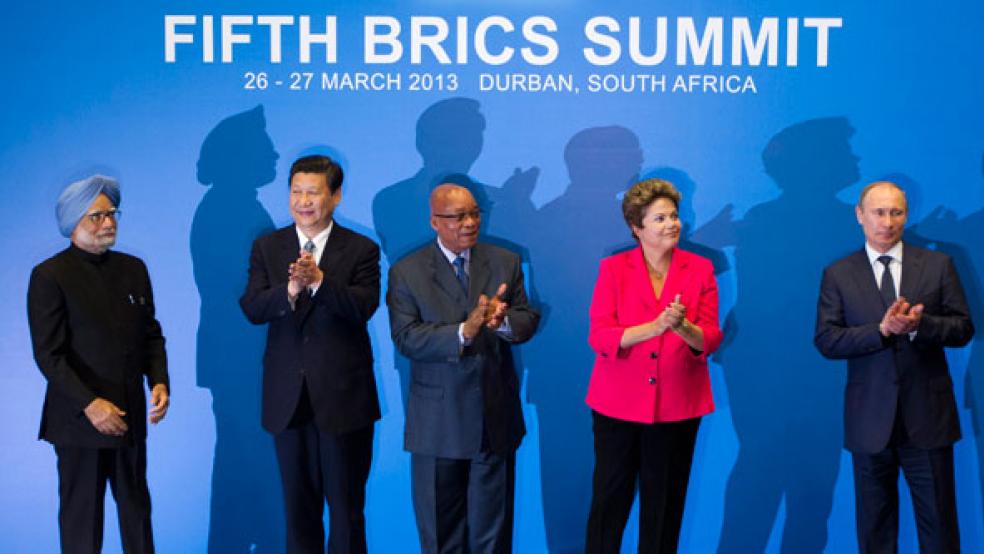Last autumn, analysts at Morgan Stanley jumped all over several key emerging markets, dubbing the Indian, Brazilian, Indonesian, Turkish and South African currencies the “Fragile Five.” Those currencies, the analysts said, would be under the most pressure relative to the U.S. dollar. The corollary: These markets wouldn’t make such great investment ideas, either.
Since then, a combination of political initiatives and higher interest rates in many of these countries has helped them begin to turn the corner and look more appealing to investors. While the jury is still out on how lasting some of the gains will be and on whether countries like Brazil will be successful in undertaking structural reforms, several of the Fragile Five have defied Morgan Stanley’s prophecies of doom, faring quite nicely so far this year.
Related: South Africa’s Zuma Promises Growth After Army Crackdown
South Africa, inexplicably enough, has joined the party. The International Monetary Fund is predicting that growth in sub-Saharan Africa overall should average 5.8 percent this year; in South Africa, the most developed country in the region, gross domestic product actually slid 0.6 percent during the first quarter of 2014, the worst performance recorded in the last five years. In spite of that, an index of the 40 largest companies on the Johannesburg Stock Exchange is ahead 11.5 percent so far this year, and up nearly 33 percent over the last 12 months. The index just hit a record high. That has taken the market into territory that traders view as overbought and, in light of the country real problems, vulnerable to a selloff.
On the surface, there are so many headwinds suggesting that South Africa should be in the doldrums – high unemployment, the highest level of income inequality of virtually any emerging market, one of the biggest budget deficits as a proportion of GDP, and a dependence on commodities at a time when the commodity supercycle has ground to a halt – that there’s no logical reason for the country’s market to do anything but crash and burn.
To believe that, though, would be to overlook two exogenous factors. The first of these could prove ephemeral, but remains a powerful force for now: the rand hedge. Trying to shield themselves from the impact of a weakening South African rand, investors pack their portfolios with consumer stocks like Richemont and British American Tobacco. Most of their profits are generated in other parts of the world, and in other currencies. In the event of a meltdown in the rand as the government keeps interest rates low, they will find shelter from any storm – or so the logic goes.
The second, longer-term key is the opportunity South African companies have in the rest of the continent. South Africa was the first country in the region to emerge as a viable investment market, but it has since been overtaken in size by Nigeria, which is now attracting the most excitement among those looking to venture into the riskier terrain of the so-called frontier markets.
South African companies are poised to profit from growth in Nigeria and elsewhere, as long as they can master nuances like local cultural patterns, regulations and transportation networks. South African Airways, for example, is considering investing in Asky, an airline based in Togo that would help it develop a West African hub. South African retail and fast-food company Shoprite has expanded into Zambia, Zimbabwe, Uganda, Madagascar, Mauritius, and even Congo, although it has withdrawn from Nigeria.
Related: Why Boko Haram Might Be Impossible to Stop
This pattern seems to suggest that treating the South African market as a single entity is a risky approach. Clearly, focusing only on the country’s significant and easily identifiable woes means that you’ll end up missing something crucial. On the other hand, indiscriminately bidding up prices of shares that have simply risen on sentiment, or are serving as short-term plays on the currency or interest rates, is more dangerous speculation, rather than investing.
The best strategy, for those with a genuine interest in capturing the “emerging” part of this particular market, is to keep a keen eye open for those businesses that are making smart, well-financed initiatives elsewhere in sub-Saharan Africa, tapping into the potential of frontier markets and delivering it up to investors in the shape of securities listed on an established and liquid “emerging” exchange. I think I’ve heard this referred to as having your cake and eating it, too.
Top Reads from The Fiscal Times:






